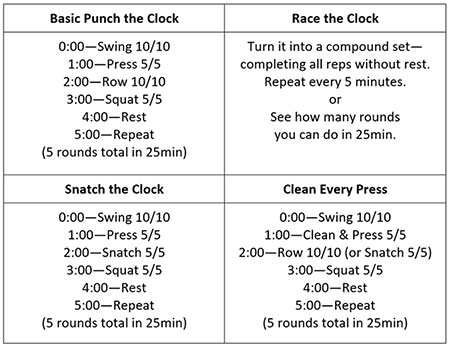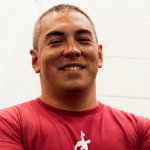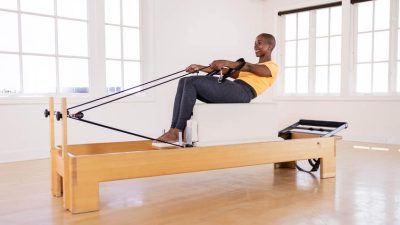
I think it was Dan John who said something to the effect that “the majority of your training will be a ‘punch the clock’ kind of session.” The younger generation might not be familiar with the expression “punch the clock”—it refers to a time clock where employees had to punch holes into a paper timecard to document the beginning and end of their shift. Hence, “punching the clock” was a crucial part of their job. What I took from this statement, is that most training sessions would be routine—nothing exciting or extraordinary. Not every training session was going to result in a personal record—far from it.
After 20+ years of training, I can tell you that consistency trumps all. And to be consistent in your training, you must be smart about it. “Going to war” with the weights, going “beast mode,” and training to failure too often will cause you to be hurt and burnt—killing any chance for consistency. Consistency requires you to do the same basic exercises with the same weights year after year. Sometimes you’ll do more, sometimes you’ll do less, but mostly you’ll be doing the same things: upper and lower body pushing and pulling. In this article I’m going to share with you my “Punch the Clock” training session. All you need is one kettlebell and about 30 minutes. I’ll also give you some ways to progress, regress, and otherwise keep things “the same but different” (a quote from Pavel). Now, without further ado, here is how you “punch the clock.”
The Basics of Punch the Clock
Everything listed below is performed with one hand, so that means 10 swings each hand and 5 squats with a racked kettlebell both left and right. Each exercise is done On the Minute (OTM) with one minute rest in minute 5. I usually have my students do 100 swings (10 x 10) or 5-10 get-ups as a warm-up before completing the session, although not necessary.
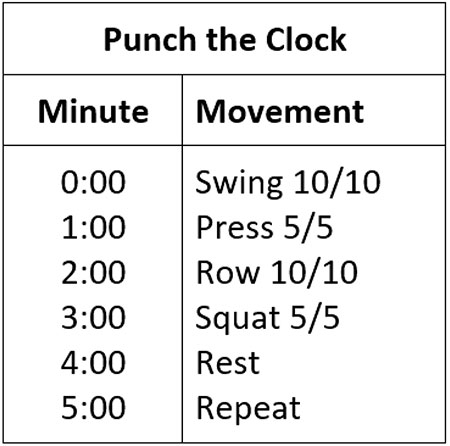
The basic version of “Punch the Clock” is a great first workout for new kettlebell-ers. I use it each month during our Visitor’s Week at Baltimore Kettlebell Club. Not only does it spread the workload by moving from a hinge to a press, to a pull, to a squat (allowing the different muscle groups to recover while still getting a cardiovascular effect) but it’s also structured for block learning, which has been shown to help skill development. In addition, structuring this OTM allows students just enough time to rest and the instructor just enough time to teach—with the extra minute at the end giving more time for both. The best thing about this training session is how easy it is to scale up or down. This is crucial when you have advanced students mixed in with newbies. Without changing any movements, the simplest way to scale up is to incorporate a version called “Race the Clock.”
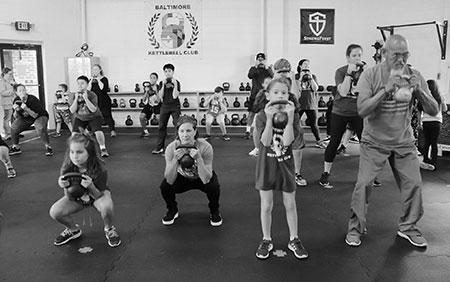
Race the Clock
Take note that these four exercises repeat every 5 minutes. Instead of doing this OTM-style you can turn it into a compound or superset. Swing, press, row, squat—without stopping. Repeat at minute 5. As a compound, this will take about 2 minutes and 30 seconds. Then you have 2 minutes and 30 seconds remaining to rest. This will be too difficult for most first-timers, so encourage them stick with the original OTM structure. Your more advanced students can perform it this way, but everybody will still restart together every 5 minutes. This maintains the “feel” of the entire class working together. Another version of “Race the Clock” would be to set a countdown timer from 25 minutes and let the athletes see how many rounds they can do. However, this is only for an advanced class and starts to move away from the routine of “punching the clock.”
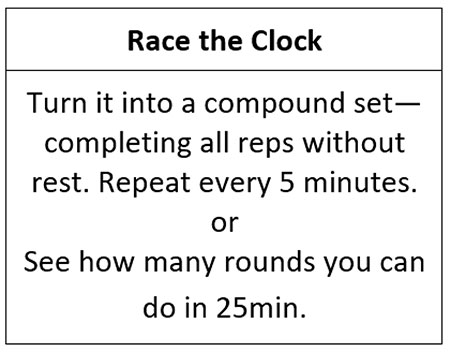
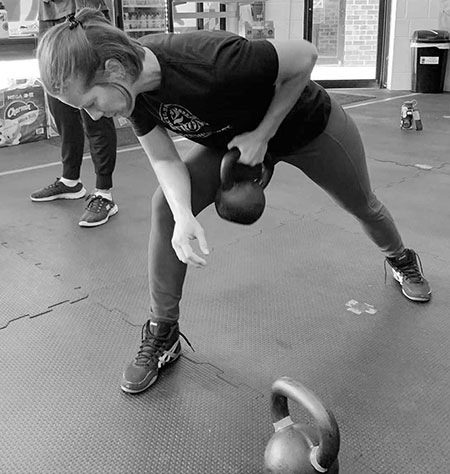
Snatch the Clock
“Snatch the Clock” is almost identical to the “Basic” version except you swap the 10/10 rows at minute 2 for 5/5 snatches. During the snatch, the kettlebell travels twice the distance as it does in a row which is why the reps are cut in half. And because it’s also an upper body pull, it’s a good substitute.
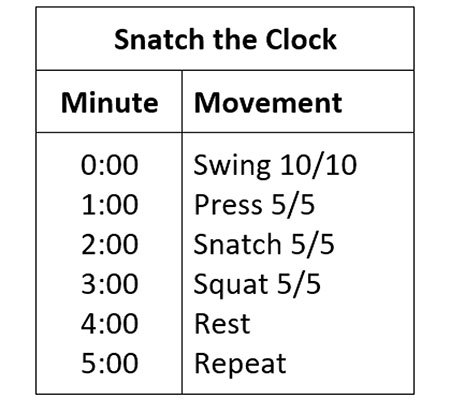
Side note: I never teach the snatch to beginners. They must first know how to swing and second demonstrate that they can control a weight overhead before they earn the right to snatch. However, this is still a good option to give to your advanced students, even in a class mixed with newbies. It’s okay to have some people snatching while others row; they’re working similar muscles and it takes about the same amount of time to complete the reps.
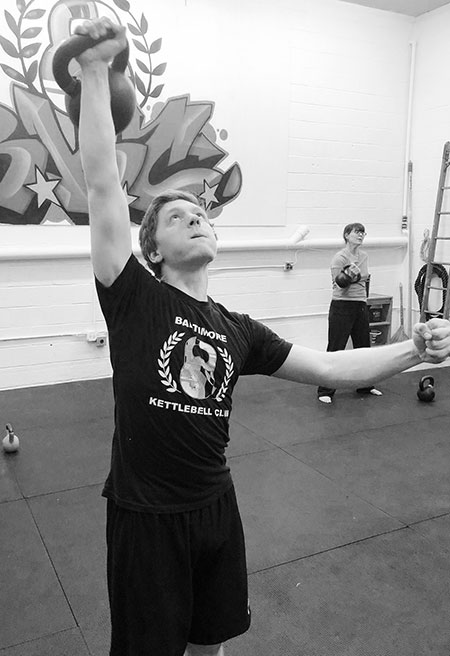
Clean Every Press
Now we’re starting to “add stuff” and not simply make substitutions. Cleaning before every press adds eight cleans to the set and takes away the rest at minute 2. Use this version sparingly, especially if you are incorporating “Snatch the Clock” as well.
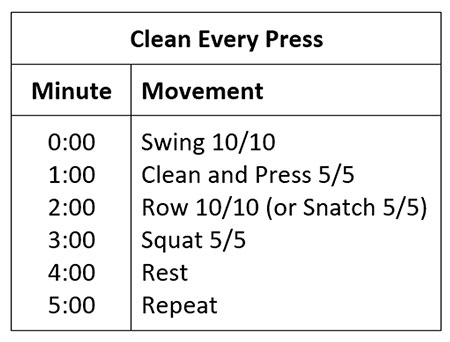
How Many Kettlebells Should You Use?
I generally don’t add or substitute anything else in my “Punch the Clock” workouts, otherwise it starts to become something different. As I said in the beginning of the article, all you need is one kettlebell. However, many people will find that they can use a heavier kettlebell for lower body exercises while still utilizing a lighter one for upper body. Or, instead of using two different sized kettlebells, you could jump up a kettlebell size for everything and do push presses and cheat rows (if necessary). You can also do a two-handed variation with a pair of kettlebells. Twice the weight in half the time. There is also a one hand variation which is done as a complex. Do all your reps with one hand before switching: 10 swings, 5 presses, 10 rows, 5 squats with your right hand, and then repeat with the left. This variation also belongs in the “Race the Clock” category.
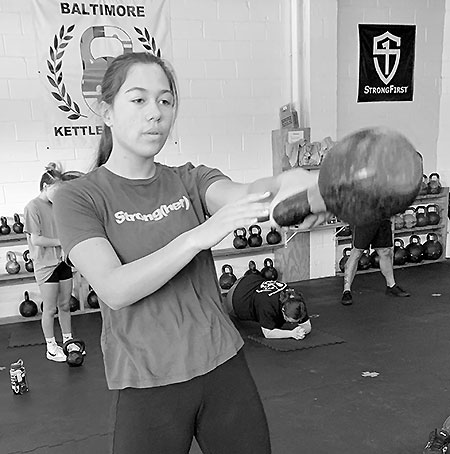
Here’s a summary of the versions I’ve described:
Conclusion
No matter which variation you choose, “Punch the Clock” is a total body training session. It includes a hinge, a squat, a pull, and a press and touches all the major muscle groups. In addition, it can quickly turn into a cardiovascular exercise. It is not only a tool to teach new students the basics of kettlebell training, but also provides a challenge for advanced athletes. “Punch the Clock” allows differentiation between skill levels in the same class, providing a challenge for each athlete. There are more variations that I could provide, but I’d rather leave room for your imagination. I invite you to make this training session your own and develop ways to adjust it as needed. A good place to start is making the “Basic Punch the Clock” version a part of your regular routine and then begin to adjust it to meet your goals. Punch the Clock—like it’s your job. Remember, consistency trumps all.
Come and train at the author’s
StrongFirst Accredited Gym in Baltimore, MD
For an international StrongFirst Accredited Gyms Directory,
